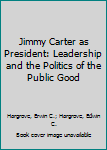Jimmy Carter as President: Leadership and the Politics of the Public Good
Select Format
Select Condition 
Book Overview
Jimmy Carter was, according to Erwin Hargrove, the first modern Democratic president to be substantially ahead of the party coalition. Concerned with issues of the future -- inflation, the need for... This description may be from another edition of this product.
Format:Hardcover
Language:English
ISBN:0807114995
ISBN13:9780807114995
Release Date:January 1988
Publisher:Louisiana State University Press
Length:211 Pages
Weight:1.30 lbs.
Dimensions:1.0" x 6.3" x 9.3"
Customer Reviews
2 ratings
Look at Carter Presidency
Published by Thriftbooks.com User , 16 years ago
I read this book for a graduate class in American history. Let me first say that I gave the book five stars for the information about the Carter Presidency, not as a comment on my approval or disapproval on the Presidency. Hargrove did an excellent job in doing the interviews and compiling the information. One gets the feeling that he was a fan of President Carter in this book. It is interesting to note that when Hargrove did his book on Presidential Leadership ten years later, he barely mentioned Carter. It seems his assessment of the Carter administration had changed. Erwin Hargrove examines how the Carter presidency was organized, how Carter approached governance, and how he saw the problems and opportunities of the office of President. The book's analyses are based on oral history interviews with Carter and his advisors, which were facilitated by the Miller Center of Public Affairs at the University of Virginia and were held in twenty-one sessions between 1981 and 1982. Hargrove asserts that Carter's proclivity for problem-solving made him more concerned about issue leadership than organizational leadership or managing the decision-making process. In his final appraisal of Carter's leadership style, Hargrove concludes that Carter skillfully led the country during adverse conditions. Hargrove illustrates that Carter's overall leadership style was collegial and comprehensive. In his collegial decision making, Carter preferred to place his trust in a small group of advisors and work through the issue, while remaining at the center of the decision. According to his Secretary of State, Cyrus Vance, "The President's manner of dealing with his senior officials was unpretentious and open minded. He listened carefully and wanted the fullest discussion before making decisions .... He emphasized the desire for a 'team spirit' among his advisors." (27). Carter preferred to surround himself with various opinions and overcome a given problem through detailed study. Therefore, he was tolerant of dissent among his advisors. Carter also strived for comprehensive solutions, preferring to fall back to his second-best choice rather than resort to incremental decision-making. For example, once Carter realized that it was politically infeasible to have a distinct Department of Education, he amended his initial desire by creating a more expanded Office of Education within the existing Department of Health, Education and Welfare. Carter's preference for working toward understanding and for tackling complex problems can be attributed to his religious and engineering background and his time as a farmer and businessman. As a deeply religious man who was raised in the Southern Baptist tradition, he believed that his entrance into politics fulfilled a calling to solve complex moral problems. "He practiced humility, charity, forgiveness and tolerance as political virtues. He did not see the world as inherently evil and sought peace through understanding rather tha
A recommended read
Published by Thriftbooks.com User , 22 years ago
This was written as part of the Miller Center Series on the American Presidency. The information within was taken from oral interviews of Carter and other key officials by academics after the end of the Carter presidency. For those who merely dismiss Carter as a poor president, I highly recommend giving this book a read.The book, in my opinion, does two things. It goes into the dynamics of Carter's leadership style and also gives information about what was happening behind the doors of the White House.In a couple words, policy and decision-making were handled two ways: collegial discussion and homework. These are key to Carter's leadership. As an engineer, Carter wished to focus on a problem, do his homework, and then join discussion about the options. As the president, he reserved the right to make the final decision. This follows his engineering and religious background. If there is a problem, solve the problem.The difficulty that arose from this was his reluctance of engaging in political maneuvering and his focus. In Washington, it is necessary at times to bargain. Carter, leading a country rebounding from the Nixon years, was determined to avoid the political battles as much as possible. In regard to focus, according to Hargrove, his focusing on a problem kept him from noticing the connection with various other problems.At the end of the book, Hargrove talks about how this leadership style worked, and did not work, in a transition presidency.Also, Hargrove talks of the different agenda items (like the economic policy and energy policy) and how the collegial style worked. More often than not, not all the departments were on the same page. This led to the administration to appear to be vacillating. Hargrove shows how this process worked in each agenda, which is very helpful. I found this helped me to focus on the specifics.I would recommend this book to anyone interested in the Carter presidency or anyone who did not like the Carter presidency. This book does have a good perspective on that time in American history.





